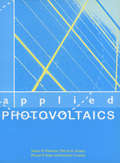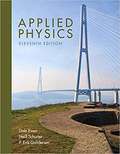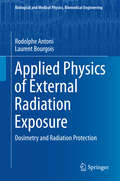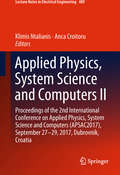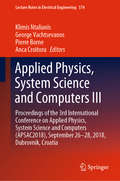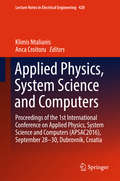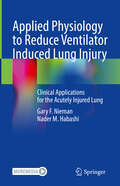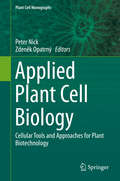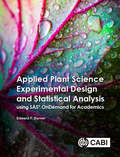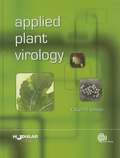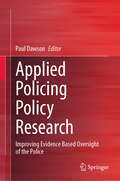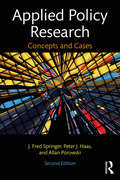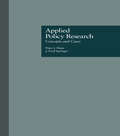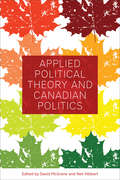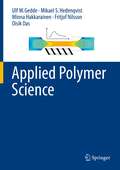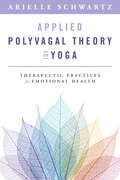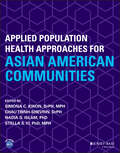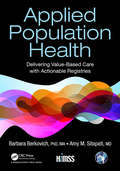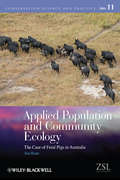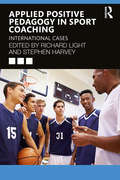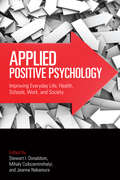- Table View
- List View
Applied Photovoltaics
by Martin A. Green Stuart R. Wenham Muriel E. Watt Richard Corkish Alistair SproulThe new edition of this thoroughly considered textbook provides a reliable, accessible and comprehensive guide for students of photovoltaic applications and renewable energy engineering. Written by a group of award-winning authors it is brimming with information and is carefully designed to meet the needs of its readers. Along with exercises and references at the end of each chapter, it features a set of detailed technical appendices that provide essential equations, data sources and standards. The new edition has been fully updated with the latest information on photovoltaic cells, modules, applications and policy. Starting from basics with 'The Characteristics of Sunlight' the reader is guided step-by-step through semiconductors and p-n junctions; the behaviour of solar cells; cell properties and design; and PV cell interconnection and module fabrication. The book covers stand-alone photovoltaic systems; specific purpose photovoltaic systems; remote area power supply systems; grid-connected photovoltaic systems and water pumping. Applied Photovoltaics is highly illustrated and very accessible, providing the reader with all the information needed to start working with photovoltaics.
Applied Photovoltaics
by Richard Corkish Martin A Green Muriel E Watt Stuart R WenhamA reliable, accessible and comprehensive guide for students of photovoltaic applications and renewable energy engineering. This thoroughly considered textbook from a group of leading influential and award-winning authors is brimming with information and is carefully designed to meet the needs of its readers. Along with exercises and references at the end of each chapter, the book features a set of detailed technical appendices that provide essential equations, data sources and standards. Starting from basics with 'The Characteristics of Sunlight' the reader is guided step-by-step through semiconductors and p-n junctions; the behaviour of solar cells; cell properties ad design; and PV cell interconnection and module fabrication. The book covers stand-alone photovoltaic systems; specific purpose photovoltaic systems; remote are power supply systems; and grid-connected photovoltaic systems. There is also a section on photovoltaic water pumping system components and design. Applied Photovolatics is well illustrated and readable with an abundance of diagrams and illustrations, and will provide the reader with all the information needed to start working with photovoltaics.
Applied Physics
by P. Erik Gundersen Neill Schurter Dale EwenApplied Physics, 11th Edition presents clear, to-the-point, topical coverage of basic physics applied to industrial and technical fields. Throughout the text, emphasis is placed on teaching students to use a consistent problem-solving methodology. A wealth of real-world applications are presented, motivating students by teaching physics concepts in context. Updated with new color photos, clarifications, and enhancements, the Eleventh Edition also features sections on physics-related careers and new technologies to engage readers in the material.
Applied Physics of External Radiation Exposure: Dosimetry and Radiation Protection (Biological and Medical Physics, Biomedical Engineering)
by Rodolphe Antoni Laurent BourgoisThis book describes the interaction of living matter with photons, neutrons, charged particles, electrons and ions. The authors are specialists in the field of radiation protection. The book synthesizes many years of experiments with external radiation exposure in the fields of dosimetry and radiation shielding in medical, industrial and research fields. It presents the basic physical concepts including dosimetry and offers a number of tools to be used by students, engineers and technicians to assess the radiological risk and the means to avoid them by calculating the appropriate shields. The theory of radiation interaction in matter is presented together with empirical formulas and abacus. Numerous numerical applications are treated to illustrate the different topics. The state of the art in radiation protection and dosimetry is presented in detail, especially in the field of simulation codes for external exposure to radiation, medical projects and advanced research. Moreover, important data spread in different up to date references are presented in this book. The book deals also with accelerators, X-rays facilities, sealed sources, dosimetry, Monte Carlo simulation and radiation regulation. Each chapter is split in two parts depending on the level of details the readers want to focus on. The first part, accessible to a large public, provides a lot of simple examples to help understanding the physics concepts under radiation external exposure. The second part, called "Additional Information" is not mandatory; it aims on explaining topics more deeply, often using mathematical formulations. The book treats fundamental radiometric and dosimetric quantities to describe the interaction in materials under the aspects of absorbed dose processes in tissues. Definitions and applications on limited and operational radiation protection quantities are given. An important aspect are practical engineering tools in industrial, medical and research domains. Source characterization and shielding design are addressed. Also more "exotic" topics, such as ultra intense laser and new generation accelerators, are treated. The state of the art is presented to help the reader to work with the book in a self-consistent way. The basic knowledge necessary to apply Monte Carlo methods in the field of radiation protection and dosimetry for external radiation exposure is provided. Coverage of topics such as variance reduction, pseudo-random number generation and statistic estimators make the book useful even to experienced Monte Carlo practitioners. Solved problems help the reader to understand the Monte Carlo process. The book is meant to be used by researchers, engineers and medical physicist. It is also valuable to technicians and students.
Applied Physics, System Science and Computers II: Proceedings of the 2nd International Conference on Applied Physics, System Science and Computers (APSAC2017), September 27-29, 2017, Dubrovnik, Croatia (Lecture Notes in Electrical Engineering #489)
by Klimis Ntalianis Anca CroitoruThis book reports on advanced theories and methods in three related fields of research: applied physics, system science and computers. It is organized in three parts, the first of which covers applied physics topics, including lasers and accelerators; condensed matter, soft matter and materials science; nanoscience and quantum engineering; atomic, molecular, optical and plasma physics; as well as nuclear and high-energy particle physics. It also addresses astrophysics, gravitation, earth and environmental science, as well as medical and biological physics. The second and third parts focus on advances in computers and system science, respectively, and report on automatic circuit control, power systems, computer communication, fluid mechanics, simulation and modeling, software engineering, data structures and applications of artificial intelligence among other areas. Offering a collection of contributions presented at the 2nd International Conference on Applied Physics, System Science and Computers (APSAC), held in Dubrovnik, Croatia on September 27–29, 2017, the book bridges the gap between applied physics and electrical engineering. It not only to presents new methods, but also promotes collaborations between different communities working on related topics at the interface between physics and engineering, with a special focus on communication, data modeling and visualization, quantum information, applied mechanics as well as bio and geophysics.
Applied Physics, System Science and Computers III: Proceedings of the 3rd International Conference on Applied Physics, System Science and Computers (APSAC2018), September 26-28, 2018, Dubrovnik, Croatia (Lecture Notes in Electrical Engineering #574)
by Pierre Borne Klimis Ntalianis Anca Croitoru George VachtsevanosThis book reports on advanced theories and methods in three related fields of research: applied physics, system science and computers. The first part covers applied physics topics, such as lasers and accelerators; fluid dynamics, optics and spectroscopy, among others. It also addresses astrophysics, security, and medical and biological physics. The second part focuses on advances in computers, such as those in the area of social networks, games, internet of things, deep learning models and more. The third part is especially related to systems science, covering swarm intelligence, smart cities, complexity and more. Advances in and application of computer communication, artificial intelligence, data analysis, simulation and modeling are also addressed. The book offers a collection of contributions presented at the 3nd International Conference on Applied Physics, System Science and Computers (APSAC), held in Dubrovnik, Croatia on September 26–28, 2018. Besides presenting new methods, it is also intended to promote collaborations between different communities working on related topics at the interface between physics, computer science and engineering.
Applied Physics, System Science and Computers: Proceedings of the 1st International Conference on Applied Physics, System Science and Computers (APSAC2016), September 28-30, Dubrovnik, Croatia (Lecture Notes in Electrical Engineering #428)
by Klimis Ntalianis Anca CroitoruThis book reports on advanced theories and methods in three related fields of research: applied physics, system science and computers. It is organized in two main parts, the first of which covers applied physics topics, including lasers and accelerators; condensed matter, soft matter and materials science; nanoscience and quantum engineering; atomic, molecular, optical and plasma physics; as well as nuclear and high-energy particle physics. It also addresses astrophysics, gravitation, earth and environmental science, as well as medical and biological physics. The second part focuses on advances in system science and computers, exploring automatic circuit control, power systems, computer communication, fluid mechanics, simulation and modeling, software engineering, data structures and applications of artificial intelligence among other areas. Offering a collection of contributions presented at the 1st International Conference on Applied Physics, System Science and Computers (APSAC 2016), the book bridges the gap between applied physics and electrical engineering. It not only to presents new methods, but also promotes collaborations between different communities working on related topics at the interface between physics and engineering, with a special focus on communication, data modeling and visualization, quantum information, applied mechanics as well as bio and geophysics.
Applied Physiology to Reduce Ventilator Induced Lung Injury: Clinical Applications for the Acutely Injured Lung
by Gary F. Nieman Nader M. HabashiThis book details the mechanisms of ventilator induced lung injury (VILI) at the alveolar level with the aim to identify optimal ventilation methods necessary to preserve lung function. Mortality associated with the acute respiratory distress syndrome (ARDS), including that caused by COVID-19, remains unacceptably high. The primary treatment is supportive in the form of protective mechanical ventilation, but set improperly this can cause an unintended secondary VILI significantly increasing mortality. To improve ventilation strategies needed to reduce VILI the alteration in alveolar mechanics caused by ARDS must be understood. The protective ventilation strategy must attempt to normalize alveolar mechanics, which would significantly reduce the mechanical damage subjected to lung tissue during mechanical ventilation. Written by leading experts with numerous diagrams, figures, and videos, this book takes the latest research in the field and translates it to clinical practice. Authors discuss the ARDS-induced alteration in alveolar mechanics that make it so susceptible to VILI and novel ventilation strategies necessary to normalize alveolar mechanics and reduce ARDS related morbidity and mortality. Chapters cover normal lung (alveolar mechanics and micro anatomy), how these are altered during acute lung injury, and the optimal Mechanical Breath Profile (MBp) necessary to stabilize and open the lung to reduce both VILI and acute lung injury-induced morbidity and mortality. This is an ideal guide for pulmonologists, critical care specialists, surgeons, and all medical professionals working with patients on ventilation.
Applied Plant Cell Biology: Cellular Tools and Approaches for Plant Biotechnology (Plant Cell Monographs #22)
by Peter Nick Zdeněk OpatrnyThe aim of this volume is to merge classical concepts of plant cell biology with the recent findings of molecular studies and real-world applications in a form attractive not only to specialists in the realm of fundamental research, but also to breeders and plant producers. Four sections deal with the control of development, the control of stress tolerance, the control of metabolic activity, and novel additions to the toolbox of modern plant cell biology in an exemplary and comprehensive manner and are targeted at a broad professional community. It serves as a clear example that a sustainable solution to the problems of food security must be firmly rooted in modern, continuously self re-evaluating cell-biological research. No green biotech without green cell biology. As advances in modern medicine is based on extensive knowledge of animal molecular cell biology, we need to understand the hidden laws of plant cells in order to handle crops, vegetables and forest trees. We need to exploit, not only empirically, their astounding developmental, physiological and metabolic plasticity, which allows plants to cope with environmental challenges and to restore flexible, but robust self-organisation.
Applied Plant Science Experimental Design and Statistical Analysis Using SAS® OnDemand for Academics
by Associate Profes Edward DurnerThe correct design, analysis and interpretation of plant science experiments is imperative for continued improvements in agricultural production worldwide. The enormous number of design and analysis options available for correctly implementing, analysing and interpreting research can be overwhelming. SAS® is the most widely used statistical software in the world and SAS® OnDemand for Academics is now freely available for academic institutions. This is a user-friendly guide to statistics using SAS® OnDemand for Academics, ideal for facilitating the design and analysis of plant science experiments. It presents the most frequently used statistical methods in an easy-to-follow and non-intimidating fashion, and teaches the appropriate use of SAS® within the context of plant science research. This book: - Covers experimental designs and data analysis protocols - Is presented as a how-to guide with many examples - Includes freely downloadable data sets - Examines key topics such as merging data frames, multivariate analysis and linear regression Authored by an experienced teacher of applied plant science statistics, this book assumes no prior background in statistics and guides users through the appropriate methodologies in research. It is an invaluable tool for advanced undergraduate and graduate students, in addition to researchers, extension consultants, faculty and technicians.
Applied Plant Virology
by Calum Rae WilsonWritten for advanced undergraduate students, this book is a practical, in-depth guide to plant virology. Beginning with an introduction to viruses and their classification, the text describes virus pathology, including how viruses enter and move through plant cells and induce disease. Subsequent chapters discuss how viruses spread in the field and how to measure this. Throughout, the book remains reader-friendly, using focus boxes for clear, easy to obtain information, enabling students to quickly access relevant information but supply sufficient detail for advanced studies. In addition to basic information on virus biology there is an additional focus on applied virology, ideal for students undertaking agricultural studies for whom study of disease and its control is essential.
Applied Police Research: Challenges and opportunities (Crime Science Series)
by Ella Cockbain Johannes KnutssonRemarkably little has been written about the theory and practice of applied police research, despite growing demand for evidence in crime prevention. Designed to fill this gap, this book offers a valuable new resource. It contains a carefully curated selection of contributions from some of the world's leading applied police researchers. Together, the authors have almost 300 years of relevant experience across three continents. The volume contains both practical everyday advice and calls for more fundamental change in how police research is created, consumed and applied. It covers diverse topics, including the art of effective collaborations, the interaction between policing, academia and policy, the interplay between theory and practice and managing ethical dilemmas. This book will interest a broad and international audience from academics and students, to police management, officers and trainees, to policymakers and research funders.
Applied Policing Policy Research: Improving Evidence Based Oversight of the Police
by Paul DawsonThis volume critically examines how the integration of evidence-based research within police governance reshapes accountability, decision-making, and policy development. Focusing on the transition of a well-established police research unit from the Metropolitan Police Service to the London Police and Crime Commissioner&’s office in 2014, the book explores the broader implications of this move for data-driven oversight and police practice. Bringing together contributions from experts directly involved in this transition, the chapters combine original research, case studies, and applied analysis to demonstrate how evidence informs policing at both strategic and operational levels. The book introduces the concept of "evidence-based oversight," offering a new framework for understanding the evolving role of research in shaping police governance and accountability structures. With insights for PCC staff, police professionals, policymakers, and scholars, this volume provides a critical perspective on how empirical research can enhance policing practices, drive reform, and strengthen oversight mechanisms within criminal justice systems.
Applied Policy Research: Concepts and Cases
by Allan Porowski J. Fred Springer Peter J. HaasWhere many textbooks on policy research focus on methodological and statistical theories, leaving students to wonder how they will apply those theories to future policy positions, this innovative textbook takes theories of policy research and puts them into practice, demystifying the subject by translating it into real-world situations in which students can actively engage. Beginning with an orientation and overview of policy research, outlining the processes of policy analysis and evaluation from start to finish, Applied Policy Research, 2e walks students through an examination of case studies to demonstrate how these theories play out in real policy situations. New to this edition: A rewritten Part I that includes several new chapters incorporating the latest developments in applicable policy research design, implementation, and products to provide a framework for conducting policy research. A matrix at the start of Part II to easily identify how each of the fifteen case-study chapters correspond with concepts and topics presented in Part I, showing the reader where to look for a specific real-life example of a given topic or concept. Each case is drawn from real instances of policy research to provide students with an opportunity to consider and learn how to grapple with the challenges posed by the needs of public programs and agencies. Cases include local, state, and nonprofit agencies as well as federal-state-local intergovernmental "hybrids." Each chapter is presented in a uniform format: (1) a detailed description of a policy research problem; (2) a discussion of the unique challenges posed by the problem; (3) a description of the policy research techniques used; (4) a summary of the outcomes or conclusions associated with the research as it was conducted; and (5) conclusions about the implications or lessons for policy research. Illustrative figures help students understand the stages of policy research, and end-of-chapter tools such as discussion questions, assignments and activities, and case studies "at a glance" help students master not only the particulars of each case but the broader skills needed in future research. Applied Policy Research, Second Edition will be essential reading in all policy research courses with a focus on practical outcomes and student preparation for public service.?
Applied Policy Research: Concepts and Cases
by J. Fred Springer Peter J. HaasFirst published in 1998. Routledge is an imprint of Taylor & Francis, an informa company.
Applied Political Theory and Canadian Politics
by David McGrane Neil HibbertBringing together political theorists and specialists in Canadian politics, Applied Political Theory and Canadian Politics combines conceptual frameworks from political theory and empirical evidence to offer fresh perspectives on political events in contemporary Canada. Examining complex and timely subjects such as equality, social justice, democracy, citizenship, and ethnic diversity, contributors present current and archival research supplemented with insights drawn from political theory to give readers a deep and nuanced understanding of increasingly pressing issues in Canadian society. For scholars and students seeking a work of political theory that is tangible, focused, and connected to the real world of everyday politics, Applied Political Theory and Canadian Politics will be an important resource, combining philosophical insights and empirical evidence to enhance our understanding of contemporary Canadian politics.
Applied Polymer Rheology
by Marianna KontopoulouExplore polymer rheology from an industrial standpoint Presenting state-of-the-art polymer rheology as observed by well-recognized authors, Applied Polymer Rheology: Polymeric Fluids with Industrial Applications is designed to help readers understand the relationship between molecular structure and the flow behavior of polymers. In particular, it focuses on polymeric systems that elicit special attention from industry. Providing a comprehensive overview of the rheological characteristics of polymeric fluids, the book bridges the gap between theory and practice/application, enabling readers to see the connection between molecular structure and the behavior of the polymers studied. Beginning with a discussion of the properties, processability, and processing aids of specific polymers, later chapters examine filled polymers and composites, and the theoretical framework upon which their analysis is based. Various systems containing microstructure are presented subsequently, with the final chapter introducing paste extrusion of polytetrafluoroethylene paste. An invaluable reference guide that covers the literature and vast array of technical approaches to polymer rheology, Applied Polymer Rheology's coverage of polymeric fluids of interest to industry make it an essential resource for plastics, polymer, and chemical engineers, materials scientists, polymer chemists, and polymer physicists to use when interpreting findings and planning experiments.
Applied Polymer Science
by Minna Hakkarainen Ulf W. Gedde Mikael S. Hedenqvist Fritjof Nilsson Oisik DasThis companion volume to “Fundamental Polymer Science” (Gedde and Hedenqvist, 2019) offers detailed insights from leading practitioners into experimental methods, simulation and modelling, mechanical and transport properties, processing, and sustainability issues. Separate chapters are devoted to thermal analysis, microscopy, spectroscopy, scattering methods, and chromatography. Special problems and pitfalls related to the study of polymers are addressed. Careful editing for consistency and cross-referencing among the chapters, high-quality graphics, worked-out examples, and numerous references to the specialist literature make “Applied Polymer Science” an essential reference for advanced students and practicing chemists, physicists, and engineers who want to solve problems with the use of polymeric materials.
Applied Polyoxometalate-Based Electrocatalysis
by Diana M. FernandesWell-researched reference on stable alternative electrocatalysts and electrode materials with the potential to transform chemistry and processes in sensor- and energy-related technologies Applied Polyoxometalate-based Electrocatalysis delivers an overview of the variety of efficient applications of free POM and POM-based (nano)composites as exciting materials in the field of electrocatalysis. With a variety of sizes, shapes, composition, and physical and chemical properties, these composites have important properties, such as the ability to undergo reversible multivalence reductions/oxidations, leading to the formation of mixed-valence species, which brings about favorable electrocatalytic properties with regard to several electrochemical processes. Edited by a highly qualified independent researcher internationally recognized for her contributions to materials for electrochemical energy-related reactions, Applied Polyoxometalate-based Electrocatalysis includes information on: General methodologies used in the preparation of free POMs and POM-based nanocomposites and different strategies employed in electrode modification Role of POM-modified electrodes in oxidative and reductive electrocatalysis, including the detection/sensing of several (bio)molecules of interest and carbon dioxide electroreduction Application of POM-based (nano)composites, including the oxygen reduction reaction relevant to fuel cells, the oxygen and hydrogen evolution reactions, and batteries and supercapacitors Applied Polyoxometalate-based Electrocatalysis is an essential reference on the subject for chemists, material scientists, chemical engineers, and institutions involved in work related to free POM and POM-based (nano)composites.
Applied Polyvagal Theory in Yoga: Therapeutic Practices for Emotional Health
by Arielle SchwartzTreat trauma holistically with the combined applications of yoga and polyvagal theory. This book focuses on the intersection of polyvagal theory, yoga, and psychotherapy by weaving together the wisdom tradition of yoga with neuroscience, attachment theory, somatic psychology, and traumatology. The application of polyvagal theory allows practitioners to compassionately support growth by enhancing the health of the autonomic nervous system, while therapeutic yoga allows one to attend to the interrelationships between mind, emotions, physiology, and behavior. Applied Polyvagal Theory in Yoga provides conscious breathing, vagal toning, mindful movement, and meditation practices that aid in rewiring the nervous system. Readers will discover how to help both clients and themselves cultivate a felt sense of ease during times of safety; enhance their capacity to handle challenges with equanimity; and reclaim their ability to recover from stress swiftly and efficiently. Applied Polyvagal Theory in Yoga offers practitioners a new and effective way to support clients who are stuck in a trauma response mode.
Applied Population Health Approaches for Asian American Communities (Public Health/Vulnerable Populations)
by Chau Trinh-Shevrin Simona C. Kwon Nadia S. Islam Stella S. YiAn insightful text exploring health disparities in Asian American populations In the newly revised Second Edition of Applied Population Health Approaches for Asian American Communities, a team of distinguished public health experts delivers a groundbreaking resource providing an in-depth examination of the soical, political, economic, and cultural forces shaping Asian American health today. Integrating up-to-date applied public health research for assessing health interventions and programs relevant to Asian American communities and other groups that have been historically marginalized, this book highlights the different frameworks, research designs, and other methodological considerations for reaching Asian American and other ethnic communities. In the latest edition of the book, readers will find contextual explorations of the Asian American population in the United States, as well as discussions of the measurement of health and risk across the lifespan in Asian American groups. It also includes: New and updated case studies showcasing the application of different frameworks and research designs Methodological considerations for reaching Asian American and other vulnerable and underserved communities Examples of successful implementations of community engagement and community-based participatory research. A valuable resource for all levels of health professionals, practitioners, and community advocates, Applied Population Health Approaches for Asian American Communities remains the leading reference for anyone conducting or studying health disparities in Asian American communities or other groups that have been marginalized.
Applied Population Health: Delivering Value-Based Care with Actionable Registries (HIMSS Book Series)
by Barbara Berkovich, PhD, MA Amy Sitapati, MDElectronic Health Record (EHR) systems today provide increasing levels of clinical decision support and are the fulcrum for change for value-based healthcare delivery. Billions of dollars of government and insurer payments are dependent on evidence-based workflow design and quality report. In this context, quality measurement is no longer a retrospective exercise, but an essential prospective process embedded in clinical operations. Population health tools in the EHR enhance the efficiency and effectiveness of interventions thus improving the quality of care at lower cost. Population health methods are effective in ensuring that the right patient receives the right care at the right time. This book provides a clear framework for design, implementation, and monitoring of innovative population health tools to accelerate measurable improvements in care delivery. Key benefits for readers include conceptual framework, team approach, and technical insights that result in improved patient care, improved performance on quality measures and increased revenue from quality performance incentives and risk-based contracts. This is also a practice guide to the healthcare professionals many roles who are eager to build or improve population health programs with the goal of delivering high quality value-based care.
Applied Population and Community Ecology: The Case of Feral Pigs in Australia (Conservation Science and Practice)
by Jim HonePart of the Zoological Society of London's Conservation Science and Practice Series, Applied Population and Community Ecology evaluates theory in population and community ecology using a case study of feral pigs, birds and plants in the high country of south-eastern Australia. In sequence, the book reviews the relevant theory and uses long-term research over a quarter of a century on the population ecology of feral pigs and then community ecology of birds and plants, to evaluate the theory. The book brings together into one volume, research results of many observational, experimental and modelling studies and directly compares them with those from related studies around the world. The implications of the results for future wildlife management are also discussed. Intended readers are ecologists, graduate students in ecology and wildlife management and conservation and pest managers.
Applied Positive Pedagogy in Sport Coaching: International Cases
by Richard LightPositive Pedagogy is an athlete-centred, inquiry-based approach that transforms the way we understand learning and coaching in sport and can be successfully employed across a range of different sports and levels of performance. Applied Positive Pedagogy in Sports Coaching: International Cases reflects the uptake of Positive Pedagogy by coaches across different countries and sport settings through its complete focus on their experiences of using it and adapting it to their needs and contexts. Comprising 17 detailed chapters that examine both Team Sports (Part 1) and Individual Sports (Part 2), this book seeks to provide insight into the opportunities and challenges involved in the application of Positive Pedagogy for sport coaching (PPed). Critically, it also identifies any problems the coaches encountered, how they addressed them and what they learned from these experiences. Acting as a complementary text to the successful Positive Pedagogy for Sport Coaching, 2nd edition, Applied Positive Pedagogy in Sports Coaching: International Cases is an exciting, applied text that will be vital reading for all practising sports coaches or physical education teachers looking to improve or even transform their professional practice, as well as sports coaching students and researchers.
Applied Positive Psychology: Improving Everyday Life, Health, Schools, Work, and Society (Applied Psychology Series)
by Mihaly Csikszentmihalyi Stewart I. Donaldson Jeanne NakamuraPositive Psychology has experienced extraordinary growth over the past decade. Emerging research in this area is suggesting new strategies for improving everyday life, healthcare, education systems, organizations and work life, and societies across the globe. This book will be of interest to all applied psychologists, applied researchers, social and organizational psychologists, and anyone interested in applying the science of positive psychology to improvement of the human condition.

